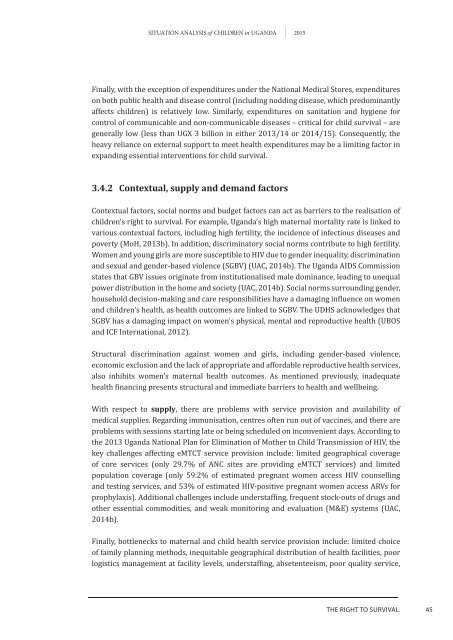Situation analySiS
1TNu802
1TNu802
Create successful ePaper yourself
Turn your PDF publications into a flip-book with our unique Google optimized e-Paper software.
<strong>Situation</strong> <strong>analySiS</strong> of Children in uganda 2015Finally, with the exception of expenditures under the National Medical Stores, expenditureson both public health and disease control (including nodding disease, which predominantlyaffects children) is relatively low. Similarly, expenditures on sanitation and hygiene forcontrol of communicable and non-communicable diseases – critical for child survival – aregenerally low (less than UGX 3 billion in either 2013/14 or 2014/15). Consequently, theheavy reliance on external support to meet health expenditures may be a limiting factor inexpanding essential interventions for child survival.3.4.2 Contextual, supply and demand factorsContextual factors, social norms and budget factors can act as barriers to the realisation ofchildren’s right to survival. For example, Uganda’s high maternal mortality rate is linked tovarious contextual factors, including high fertility, the incidence of infectious diseases andpoverty (MoH, 2013b). In addition, discriminatory social norms contribute to high fertility.Women and young girls are more susceptible to HIV due to gender inequality, discriminationand sexual and gender-based violence (SGBV) (UAC, 2014b). The Uganda AIDS Commissionstates that GBV issues originate from institutionalised male dominance, leading to unequalpower distribution in the home and society (UAC, 2014b). Social norms surrounding gender,household decision-making and care responsibilities have a damaging influence on womenand children’s health, as health outcomes are linked to SGBV. The UDHS acknowledges thatSGBV has a damaging impact on women’s physical, mental and reproductive health (UBOSand ICF International, 2012).Structural discrimination against women and girls, including gender-based violence,economic exclusion and the lack of appropriate and affordable reproductive health services,also inhibits women’s maternal health outcomes. As mentioned previously, inadequatehealth financing presents structural and immediate barriers to health and wellbeing.With respect to supply, there are problems with service provision and availability ofmedical supplies. Regarding immunisation, centres often run out of vaccines, and there areproblems with sessions starting late or being scheduled on inconvenient days. According tothe 2013 Uganda National Plan for Elimination of Mother to Child Transmission of HIV, thekey challenges affecting eMTCT service provision include: limited geographical coverageof core services (only 29.7% of ANC sites are providing eMTCT services) and limitedpopulation coverage (only 59.2% of estimated pregnant women access HIV counsellingand testing services, and 53% of estimated HIV-positive pregnant women access ARVs forprophylaxis). Additional challenges include understaffing, frequent stock-outs of drugs andother essential commodities, and weak monitoring and evaluation (M&E) systems (UAC,2014b).Finally, bottlenecks to maternal and child health service provision include: limited choiceof family planning methods, inequitable geographical distribution of health facilities, poorlogistics management at facility levels, understaffing, absetenteeism, poor quality service,thE rIGht to SUrvIvaL45




